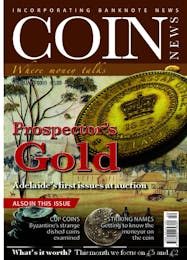Your country needs……less moaning!
I HAVE lost count of the number of times the newspapers, and more recently social media, have criticised the new designs as they appear on British coins, whether obverse or reverse. I remember when the £2 coin came in and people moaned that it wasn’t in keeping with the rest of the heraldic UK designs. I remember when the Maklouf effigy was replaced by the current Rank-Broadley one and the chattering classes were out in force complaining that it made Her Majesty the Queen look too old and, dare one say it, slightly plump. I remember the debate as to whether the “three lions” on the 1997 £1 coin weren’t in fact leopards and I have been involved with countless debates with collectors, and in the media, regarding the plethora of designs for the £2 coin and 50p coming out of Llantrisant these days. The latest furore surrounds the 2014 £2 coin to commemorate the 100th anniversary of the start of World War I.
The coin, as shown in last month’s COIN NEWS, depicts the iconic poster of Lord Kitchener pointing at the observer and insisting that their country needs them. Apparently there is an on-line petition calling for a coin design that more appropriately reflects the suffering and sacrifice of the average soldier rather than one that shows a man who, to many, represents the upper classes who are widely considered to have needlessly caused the deaths of thousands with their sheer bloody-mindedness and apparent inability to change tactics despite overwhelming evidence to suggest what they were doing wasn’t working. To a certain extent I can see the point of those complaining—after all World War I was the bloodiest of conflicts and one where everyone, every family in the land and far beyond, felt the effects. This was the war to end all wars; it was unlike anything that had gone before and as it was the common man, not just the regular soldier, who was pushed to the fore isn’t it right that what they did, what they sacrificed, should be remembered now? Well yes, but hold on a second, this is only the first year of the 100th anniversary commemorations; 2014 sees exactly 100 years since the British Empire declared war on the “evil Hun” and the “Contemptible little army” set off for France to push the Germans into the sea. It would, of course, be all over by Christmas and nobody expected the next four years of hell. The muck and mud of the trenches, the deadly “over the top” calls and the butcher’s yards of the Somme etc. that are, to most people’s minds, the archetypal image of World War I would come later. The war of 1914 featured some trench warfare, yes, but nothing like what was to come and even in the winter of that year the conditions were nowhere near as dreadful as they were to become.
The army of 1914 was a reasonably mobile one of mainly regulars; there were some territorials and some volunteers but these were not the conscripts ripped from their homes and plunged into a nightmare with little or no experience or training that was to typify the army of 1916–18 and as such I would humbly suggest to those moaning about the £2 coin that they’ve rather missed the point (not to mention that they are trying to put modern day values onto history as so many of these people seem to do) and they would be better off waiting to see what the Royal Mint will come up with in the next few years rather than moaning now.
The new coin’s design shows an image familiar to many, then and now. It also shows an image very iconic to the age: this was still the age of Empire, still a time when the call from the upper classes was heeded by the lower orders, and whilst none knew what was to come, many happily answered Kitchener’s call, proudly heading to recruiting stations to “do their duty”. This is a perfect image to commemorate 1914, because whether the moaners like it or not, that’s how things were. With this in mind I would say that the Royal Mint has got this one right—they don’t always and the sheer number of different designs coming out of South Wales is sometimes bewildering, but on this occasion I don’t see a problem. Those who are complaining have, I think, jumped too soon —we don’t know what the designers have up their sleeves for 2015–18 and it is more than possible that the horrors of war and the sacrifice of ordinary men may well find itself on a UK coin at some point in the next four years. Of course, then what we will have is an on-line petition complaining about the subject being too graphic and not a suitable one for a coin . . . you know what they say: you can’t please all of the people all of the time, and after years of hearing debates like this I can certainly confirm that!

Archives
-
2024 (7 articles)
-
2023 (35 articles)
-
2022 (19 articles)
-
2021 (31 articles)
-
2020 (45 articles)
-
2019 (26 articles)
-
2018 (28 articles)
-
2017 (25 articles)
-
2016 (23 articles)
-
2015 (21 articles)
-
2014 (30 articles)
-
2013 (31 articles)
-
2012 (44 articles)
-
2011 (36 articles)
-
2010 (50 articles)
-
2009 (38 articles)
-
2008 (47 articles)
-
2007 (34 articles)
-
2006 (31 articles)
-
2005 (12 articles)
-
2004 (6 articles)
-
2003 (11 articles)
-
2002 (5 articles)
-
2001 (5 articles)









